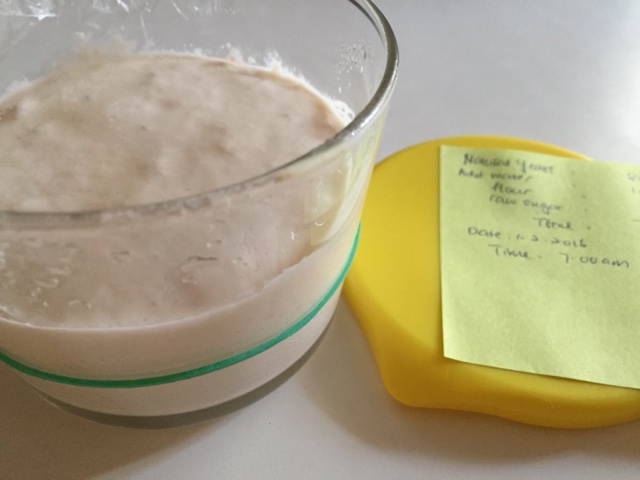A soft and fragrant bread roll with sweet scent coming from the natural pandan leaf, and coconut from the added coconut oil and coconut cream powder. A few reconstituted coconut bits gave the bread some surprised crunchiness :)
Yield: 9x7cm buns
Raw dough weight : ~435g
Appliances: Whirlpool breadmaker BM1000
Natural Yeast (100% hydration)
Day Temperature: 30 degree Celsius
Ingredients
60 g natural yeast poolish dough
10g cool boiled water
10g unbleached bread flour
1g raw sugar
Click the link for the method of cultivating natural yeast:
Directions
1. Feed the room temperature natural yeast poolish dough with 10g each of cool boiled water and bread flour, as well as 1g of raw sugar*. Allow the natural yeast to double in volume. This may take about 1 to 3 hours depending on the yeast strength.
* As my natural yeast has been rest for too long, raw sugar was being added to invigorate the natural yeast faster.
Feeding
1 hour after feeding, the poolish dough has grown more than double.
Using fridge-cold ingredients if possible
Ingredient A
8~10g pandan leaves
90g cold fresh milk
15g condensed milk
Ingredient B
20g beaten egg
35g raw sugar
1/4 tsp salt
20g coconut/vegetable oil
Ingredient C
180g bread flour
20g cake/top flour
50g natural yeast
Ingredient D
1/2 tsp instant dry yeast
Ingredient E (optional)
10g dried coconut stripes
Ingredient F
Some beaten egg for glazing
1 tbsp coconut cream (optional)
Direction
1. Cut ingredient E into bit size and add 1/2 tsp of hot water to it. Wrap with food wrap. Set aside till needed.
2. Blend milk and pandan leaf from ingredient A in a food processor.
Add condensed milk to the pandan-milk mixture, blend well.
3. Pour ingredient A and B into the bread pan.
4. Add ingredient C on top of ingredient A and B.
Adding natural yeast
5. Dig a hole in the centre of the flour, and pour ingredient D in.
6. Select "kneading" function and press start. The process will take about 1:30 hour to complete.
7. After the program ends, let the dough sits in the bread pan for about 15 to 20 minutes.
As cold ingredients have been used in this recipe, they slowdown the proofing process. Therefore, it needs the extra time for the dough to rise taller.
8. Invert the dough out of the bread pan and onto a floured work top.
Press down the dough to release the trapped air.
Wear a pair of disposable gloves to handle the rather sticky dough.
9. Divide the dough into 9 equal portions, about 48g each.
10. Roll the dough up, pull down the sides, and seal at the bottom, into a small dough ball.
Cover and let the dough balls rest for 15 minutes.
11. Take a dough ball and roll it into an elongated dough.
Flip over and fold in the two wings
Roll the dough into a long stripe again.
Roll up and pinch to seal at the end.
Coat the bottom of the dough with some flour and arrange the doughs in a non-stick pan.
11. Give the doughs a few sprays of water and transfer to a closed and warm oven to undergo second proofing for about 30 to 40 minutes, or till the doughs almost double in size.
12. Remove the tray of doughs from the oven and start pre-heating the oven to 170 degree Celsius.
Apply beaten egg over the top of the dough.
13. Bake the dough in the oven at 170 degree Celsius for about 17 to 20 minutes or till the top becomes golden.
At lower rack of the oven.
14. Transfer the bread roll out of the oven and apply butter over the top.
Sprinkle some coconut cream powder over the top for added flavour.
This step is optional.












































No comments:
Post a Comment
I love seeing your comment and sharing it with other readers. Your comment would be published after moderation. Thank you :)